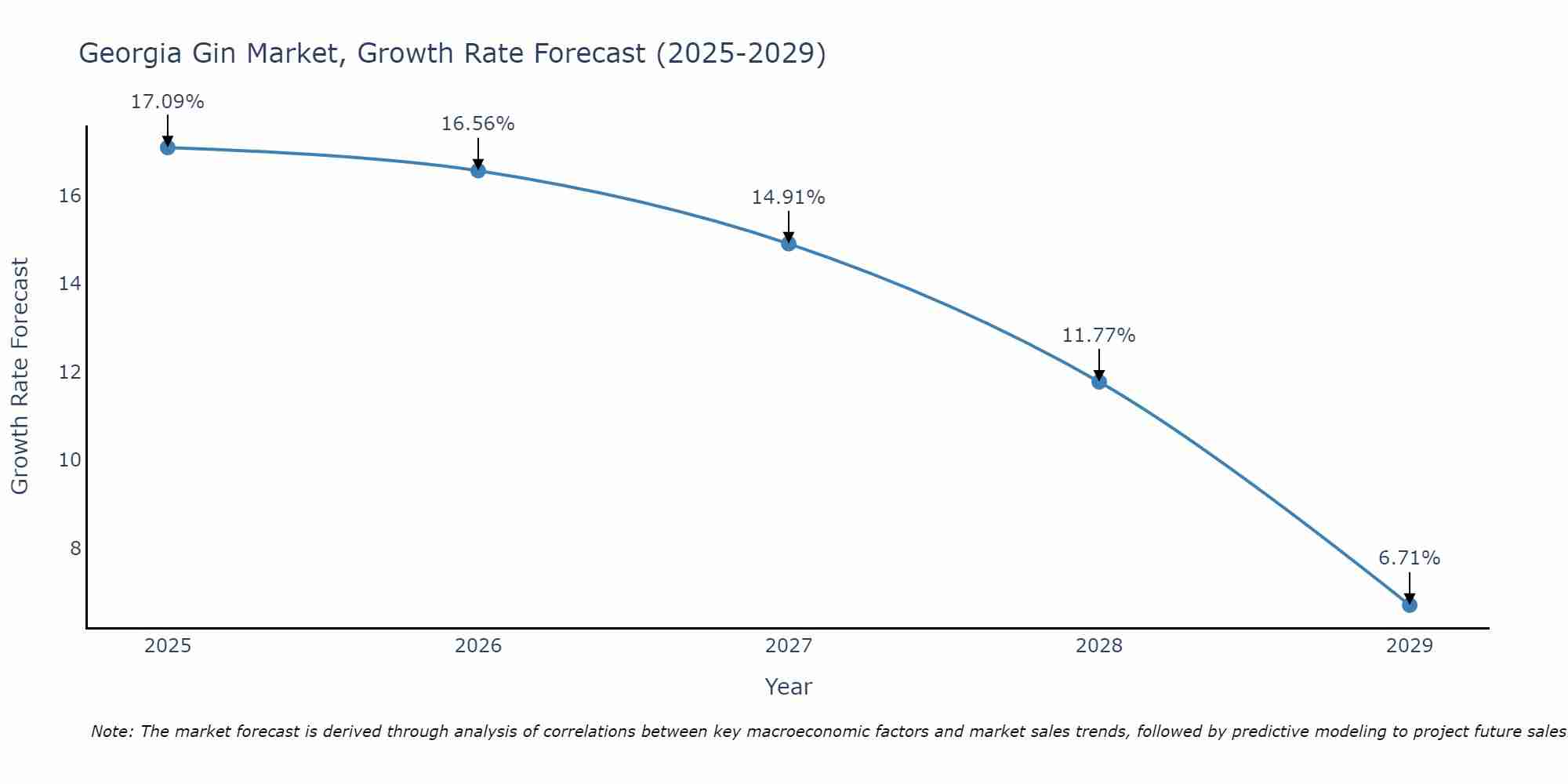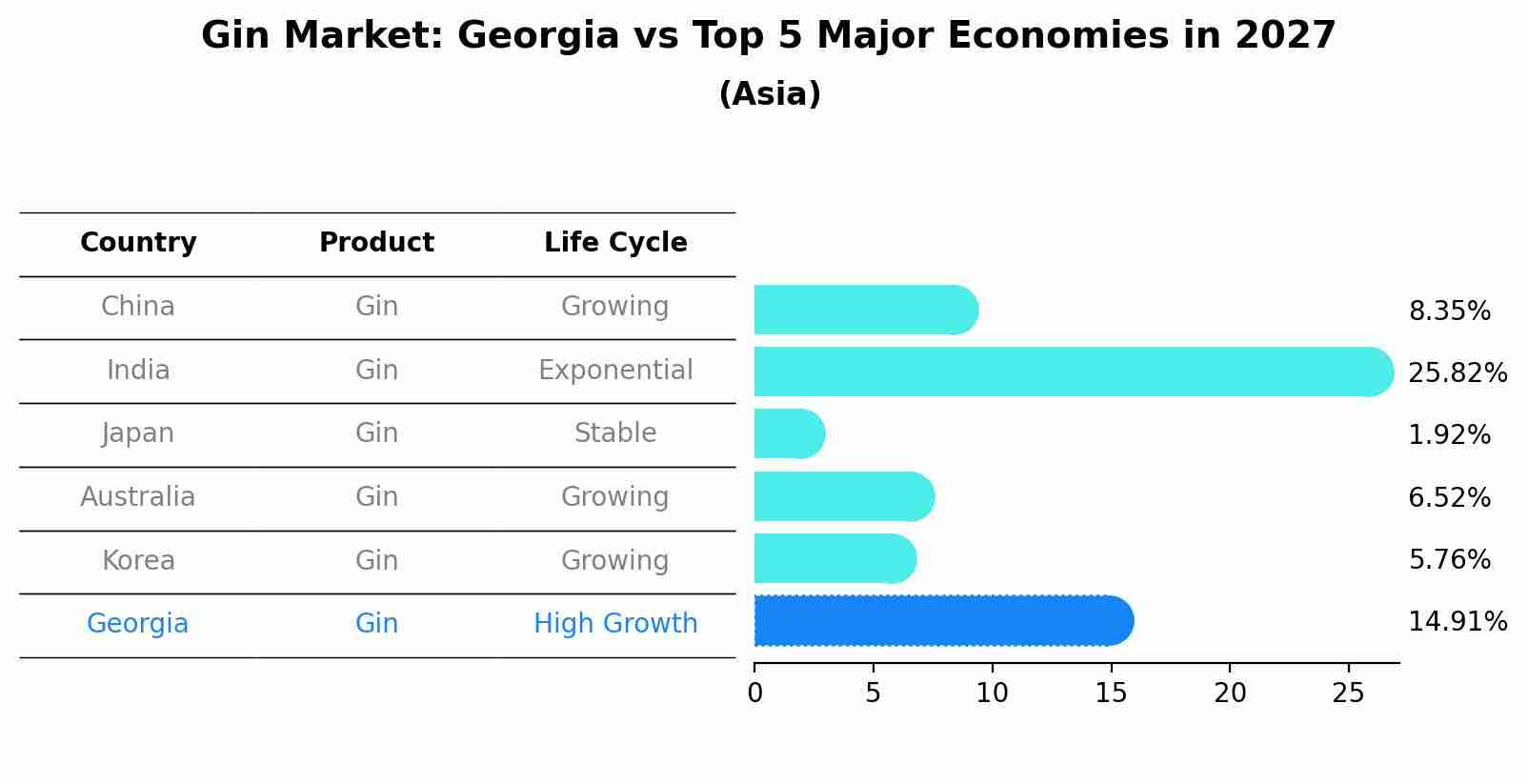Georgia Gin Market Outlook | Industry, Forecast, Growth, Analysis, Share, Trends, Companies, COVID-19 IMPACT, Revenue, Size & Value
| Product Code: ETC127318 | Publication Date: Jun 2021 | Updated Date: Apr 2025 | Product Type: Report | |
| Publisher: 6Wresearch | Author: Ravi Bhandari | No. of Pages: 70 | No. of Figures: 35 | No. of Tables: 5 |
Georgia Gin Market Size Growth Rate
The Georgia Gin Market could see a tapering of growth rates over 2025 to 2029. Although the growth rate starts strong at 17.09% in 2025, it steadily loses momentum, ending at 6.71% by 2029.

Gin Market: Georgia vs Top 5 Major Economies in 2027 (Asia)
The Gin market in Georgia is projected to grow at a high growth rate of 14.91% by 2027, highlighting the country's increasing focus on advanced technologies within the Asia region, where China holds the dominant position, followed closely by India, Japan, Australia and South Korea, shaping overall regional demand.

Georgia Gin Market Overview
The Georgia gin market is experiencing a resurgence driven by the increasing popularity of craft spirits and artisanal beverages among consumers in the state. Gin, a versatile and botanical-infused spirit, is witnessing growing demand in bars, restaurants, and retail outlets across Georgia, supported by the emergence of local distilleries and innovative flavor profiles.
Drivers of the market
The Georgia gin market is witnessing notable growth driven by several key factors. Gin, a distilled alcoholic beverage, is gaining popularity among consumers due to its versatility in cocktails and unique flavor profiles. The increasing demand for craft spirits, premiumization trends, and the rising popularity of gin-based cocktails are driving the consumption of gin in Georgia. Moreover, the growing number of craft distilleries, innovative product offerings, and the influence of mixology culture are further fueling market growth in the region.
Challenges of the market
The Georgia Gin Market encounters challenges related to market differentiation and brand recognition. While the popularity of gin has surged in recent years, fueled by the craft cocktail movement and consumer interest in artisanal spirits, the market has become increasingly crowded with numerous brands competing for shelf space and consumer attention. Establishing a unique brand identity, communicating product quality, and building brand loyalty are essential challenges for gin producers in Georgia.
Government Policy of the market
The government of Georgia has implemented policies to support the growth of the gin market in the state`s alcoholic beverage industry. Gin, a distilled spirit flavored primarily with juniper berries and other botanicals, has experienced a resurgence in popularity among consumers, both domestically and internationally. One such policy is the streamlining of licensing and regulatory processes for craft distilleries and microbreweries to encourage entrepreneurship and innovation in gin production. Additionally, the government provides financial incentives and technical assistance for small-scale gin producers to invest in equipment, quality control measures, and marketing initiatives to compete in the market effectively. Furthermore, the government collaborates with industry associations and tourism agencies to promote Georgia gin distilleries as tourist destinations, offering guided tours, tastings, and immersive experiences to visitors. These policies collectively aim to stimulate investment, job creation, and tourism revenue in the gin market, showcasing Georgia rich heritage and culinary innovation to a global audience.
Key Highlights of the Report:
- Georgia Gin Market Outlook
- Market Size of Georgia Gin Market, 2020
- Forecast of Georgia Gin Market, 2027
- Historical Data and Forecast of Georgia Gin Revenues & Volume for the Period 2018 - 2027
- Georgia Gin Market Trend Evolution
- Georgia Gin Market Drivers and Challenges
- Georgia Gin Price Trends
- Georgia Gin Porter's Five Forces
- Georgia Gin Industry Life Cycle
- Historical Data and Forecast of Georgia Gin Market Revenues & Volume By Product Type for the Period 2018 - 2027
- Historical Data and Forecast of Georgia Gin Market Revenues & Volume By London Dry Gin for the Period 2018 - 2027
- Historical Data and Forecast of Georgia Gin Market Revenues & Volume By Plymouth Gin for the Period 2018 - 2027
- Historical Data and Forecast of Georgia Gin Market Revenues & Volume By Genever/Dutch Gin for the Period 2018 - 2027
- Historical Data and Forecast of Georgia Gin Market Revenues & Volume By Old Tim Gin for the Period 2018 - 2027
- Historical Data and Forecast of Georgia Gin Market Revenues & Volume By New American Gin for the Period 2018 - 2027
- Historical Data and Forecast of Georgia Gin Market Revenues & Volume By Production Method for the Period 2018 - 2027
- Historical Data and Forecast of Georgia Gin Market Revenues & Volume By Pot Distilled Gin for the Period 2018 - 2027
- Historical Data and Forecast of Georgia Gin Market Revenues & Volume By Column Distilled Gin for the Period 2018 - 2027
- Historical Data and Forecast of Georgia Gin Market Revenues & Volume By Compound Gin for the Period 2018 - 2027
- Historical Data and Forecast of Georgia Gin Market Revenues & Volume By Distribution Channel for the Period 2018 - 2027
- Historical Data and Forecast of Georgia Gin Market Revenues & Volume By Hypermarkets and Supermarkets for the Period 2018 - 2027
- Historical Data and Forecast of Georgia Gin Market Revenues & Volume By Specialty Stores for the Period 2018 - 2027
- Historical Data and Forecast of Georgia Gin Market Revenues & Volume By Drug Stores for the Period 2018 - 2027
- Historical Data and Forecast of Georgia Gin Market Revenues & Volume By Online Channel for the Period 2018 - 2027
- Historical Data and Forecast of Georgia Gin Market Revenues & Volume By HoReCa for the Period 2018 - 2027
- Historical Data and Forecast of Georgia Gin Market Revenues & Volume By Others for the Period 2018 - 2027
- Georgia Gin Import Export Trade Statistics
- Market Opportunity Assessment By Product Type
- Market Opportunity Assessment By Production Method
- Market Opportunity Assessment By Distribution Channel
- Georgia Gin Top Companies Market Share
- Georgia Gin Competitive Benchmarking By Technical and Operational Parameters
- Georgia Gin Company Profiles
- Georgia Gin Key Strategic Recommendations
Frequently Asked Questions About the Market Study (FAQs):
Georgia Gin |
1 Executive Summary |
2 Introduction |
2.1 Key Highlights of the Report |
2.2 Report Description |
2.3 Market Scope & Segmentation |
2.4 Research Methodology |
2.5 Assumptions |
3 Georgia Gin Market Overview |
3.1 Georgia Country Macro Economic Indicators |
3.2 Georgia Gin Market Revenues & Volume, 2020 & 2027F |
3.3 Georgia Gin Market - Industry Life Cycle |
3.4 Georgia Gin Market - Porter's Five Forces |
3.5 Georgia Gin Market Revenues & Volume Share, By Product Type, 2020 & 2027F |
3.6 Georgia Gin Market Revenues & Volume Share, By Production Method, 2020 & 2027F |
3.7 Georgia Gin Market Revenues & Volume Share, By Distribution Channel, 2020 & 2027F |
4 Georgia Gin Market Dynamics |
4.1 Impact Analysis |
4.2 Market Drivers |
4.3 Market Restraints |
5 Georgia Gin Market Trends |
6 Georgia Gin Market, By Types |
6.1 Georgia Gin Market, By Product Type |
6.1.1 Overview and Analysis |
6.1.2 Georgia Gin Market Revenues & Volume, By Product Type, 2018 - 2027F |
6.1.3 Georgia Gin Market Revenues & Volume, By London Dry Gin, 2018 - 2027F |
6.1.4 Georgia Gin Market Revenues & Volume, By Plymouth Gin, 2018 - 2027F |
6.1.5 Georgia Gin Market Revenues & Volume, By Genever/Dutch Gin, 2018 - 2027F |
6.1.6 Georgia Gin Market Revenues & Volume, By Old Tim Gin, 2018 - 2027F |
6.1.7 Georgia Gin Market Revenues & Volume, By New American Gin, 2018 - 2027F |
6.2 Georgia Gin Market, By Production Method |
6.2.1 Overview and Analysis |
6.2.2 Georgia Gin Market Revenues & Volume, By Pot Distilled Gin, 2018 - 2027F |
6.2.3 Georgia Gin Market Revenues & Volume, By Column Distilled Gin, 2018 - 2027F |
6.2.4 Georgia Gin Market Revenues & Volume, By Compound Gin, 2018 - 2027F |
6.3 Georgia Gin Market, By Distribution Channel |
6.3.1 Overview and Analysis |
6.3.2 Georgia Gin Market Revenues & Volume, By Hypermarkets and Supermarkets, 2018 - 2027F |
6.3.3 Georgia Gin Market Revenues & Volume, By Specialty Stores, 2018 - 2027F |
6.3.4 Georgia Gin Market Revenues & Volume, By Drug Stores, 2018 - 2027F |
6.3.5 Georgia Gin Market Revenues & Volume, By Online Channel, 2018 - 2027F |
6.3.6 Georgia Gin Market Revenues & Volume, By HoReCa, 2018 - 2027F |
6.3.7 Georgia Gin Market Revenues & Volume, By Others, 2018 - 2027F |
7 Georgia Gin Market Import-Export Trade Statistics |
7.1 Georgia Gin Market Export to Major Countries |
7.2 Georgia Gin Market Imports from Major Countries |
8 Georgia Gin Market Key Performance Indicators |
9 Georgia Gin Market - Opportunity Assessment |
9.1 Georgia Gin Market Opportunity Assessment, By Product Type, 2020 & 2027F |
9.2 Georgia Gin Market Opportunity Assessment, By Production Method, 2020 & 2027F |
9.3 Georgia Gin Market Opportunity Assessment, By Distribution Channel, 2020 & 2027F |
10 Georgia Gin Market - Competitive Landscape |
10.1 Georgia Gin Market Revenue Share, By Companies, 2020 |
10.2 Georgia Gin Market Competitive Benchmarking, By Operating and Technical Parameters |
11 Company Profiles |
12 Recommendations |
13 Disclaimer |
- Single User License$ 1,995
- Department License$ 2,400
- Site License$ 3,120
- Global License$ 3,795
Search
Thought Leadership and Analyst Meet
Our Clients
Related Reports
- Canada Oil and Gas Market (2026-2032) | Share, Segmentation, Value, Industry, Trends, Forecast, Analysis, Size & Revenue, Growth, Competitive Landscape, Outlook, Companies
- Germany Breakfast Food Market (2026-2032) | Industry, Share, Growth, Size, Companies, Value, Analysis, Revenue, Trends, Forecast & Outlook
- Australia Briquette Market (2025-2031) | Growth, Size, Revenue, Forecast, Analysis, Trends, Value, Share, Industry & Companies
- Vietnam System Integrator Market (2025-2031) | Size, Companies, Analysis, Industry, Value, Forecast, Growth, Trends, Revenue & Share
- ASEAN and Thailand Brain Health Supplements Market (2025-2031) | Strategy, Consumer Insights, Analysis, Investment Trends, Opportunities, Growth, Size, Share, Industry, Revenue, Segments, Value, Segmentation, Supply, Forecast, Restraints, Outlook, Competition, Drivers, Trends, Demand, Pricing Analysis, Competitive, Strategic Insights, Companies, Challenges
- ASEAN Bearings Market (2025-2031) | Strategy, Consumer Insights, Analysis, Investment Trends, Opportunities, Growth, Size, Share, Industry, Revenue, Segments, Value, Segmentation, Supply, Forecast, Restraints, Outlook, Competition, Drivers, Trends, Demand, Pricing Analysis, Competitive, Strategic Insights, Companies, Challenges
- Europe Flooring Market (2025-2031) | Outlook, Share, Industry, Trends, Forecast, Companies, Revenue, Size, Analysis, Growth & Value
- Saudi Arabia Manlift Market (2025-2031) | Outlook, Size, Growth, Trends, Companies, Industry, Revenue, Value, Share, Forecast & Analysis
- Uganda Excavator, Crane, and Wheel Loaders Market (2025-2031) | Strategy, Consumer Insights, Analysis, Investment Trends, Opportunities, Growth, Size, Share, Industry, Revenue, Segments, Value, Segmentation, Supply, Forecast, Restraints, Outlook, Competition, Drivers, Trends, Demand, Pricing Analysis, Competitive, Strategic Insights, Companies, Challenges
- Rwanda Excavator, Crane, and Wheel Loaders Market (2025-2031) | Strategy, Consumer Insights, Analysis, Investment Trends, Opportunities, Growth, Size, Share, Industry, Revenue, Segments, Value, Segmentation, Supply, Forecast, Restraints, Outlook, Competition, Drivers, Trends, Demand, Pricing Analysis, Competitive, Strategic Insights, Companies, Challenges
Industry Events and Analyst Meet
Whitepaper
- Middle East & Africa Commercial Security Market Click here to view more.
- Middle East & Africa Fire Safety Systems & Equipment Market Click here to view more.
- GCC Drone Market Click here to view more.
- Middle East Lighting Fixture Market Click here to view more.
- GCC Physical & Perimeter Security Market Click here to view more.
6WResearch In News
- Doha a strategic location for EV manufacturing hub: IPA Qatar
- Demand for luxury TVs surging in the GCC, says Samsung
- Empowering Growth: The Thriving Journey of Bangladesh’s Cable Industry
- Demand for luxury TVs surging in the GCC, says Samsung
- Video call with a traditional healer? Once unthinkable, it’s now common in South Africa
- Intelligent Buildings To Smooth GCC’s Path To Net Zero


















